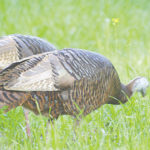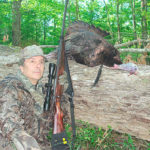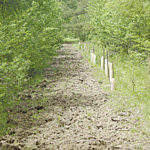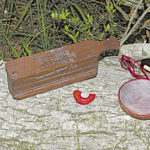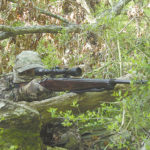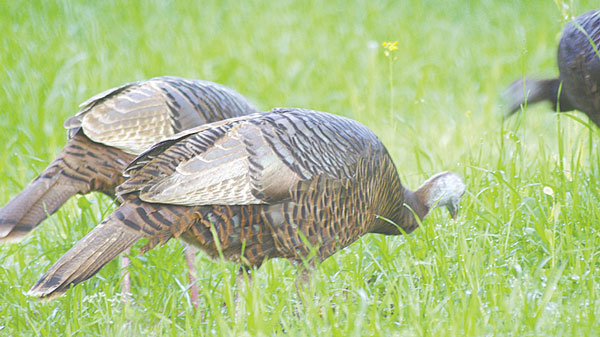
This retired biologist makes a case for the late season being the best time of the year — provided you’ve already written your check to Uncle Sam.
My story begins a week prior to the opening of the 2009 turkey season. I had not had the opportunity to scout and listen for gobbling activity on the small tract of land in East Feliciana Parish that I hunt, so the Friday before the youth weekend, I left Baton Rouge with the my cameras in hopes of hearing and photographing some turkeys. My blind had been set-up all deer season in the crown of a fallen sawtooth oak, compliments of Hurricane Gustav. Turkeys had been using the patch during the deer season, and I had bush-hogged the turkey strips in February, but had not visited the site since doing that to check for sign.
I was running late as I walked the woods trail to the patch, but I really was not concerned about spooking turkeys since they generally roosted on adjacent property and would pass through this property during the course of their daily activities — at least this was their routine in 2008.
However, when the barred owl voiced his familiar hoot and two toms sounded off in the pine plantation right in front of me, I went on alert. I certainly didn’t want to spook them, so I ever so slowly made my way up the trail to the blind.
The two toms gobbled several more times and one was very close, but fortunately there was enough vegetation that he could not see me. The other one was right on the edge of the patch about 50 yards away from the blind.
I settled into the blind, and began getting the camera gear ready. After completing this task, I took out my homemade wing-bone call, and made a soft tree yelp. The toms responded immediately. I put the call away and waited, watching with a smile as the farthest gobbler pitched down into the patch and immediately went into a strut. The other gobbler flew down into the plantation, walked into the patch and began to display also.
The light wasn’t quite good enough for the auto lenses, and the shutter speed was too slow.
The two toms headed my way, and then disappeared up the trail that I had walked in on.
In a few minutes I could hear the gobblers hooking up with the hens, and for the next 30 minutes there was nothing but turkey talk in the air. No doubt the toms got into it with one another, and there probably was some breeding going on.
LDWF turkey biologist Larry Savage has always recommended a statewide season that opened the last weekend of March. According to Savage, this would make certain that the majority of hens would be bred prior to the hunting season opening. His reasoning for doing this was exactly what I was hearing and somewhat seeing.
Unlike many other states such as Mississippi and Missouri, Louisiana does not have a strong statewide turkey population. There are some areas in the state with better populations than others. Our turkey habitat is fragmented due to urbanization in rural areas. Habitat destruction due to hurricanes in South and southeast Louisiana has also taken its toll.
States that have good habitat and good turkey populations can afford to have an early season (Mississippi opens on March 15). Hunters like early seasons because the forest has not yet fully leafed-out, providing good visibility and hearing.
Had our 2009 season opened the next day, March 21, it probably would have been fairly easy to harvest one of these two toms. I’m glad they had a full week to be with these hens before the season opened.
Finally, the hens began moving into the patch followed by the two strutting longbeards. The light was fine for photos, and I was getting some pretty good shots. A third longbeard gobbled and came into the patch from the northeast, but these two toms were quick to defend their hens, and chased him out.
After about two hours of feeding, the hens moved off to the northwest woods, followed by the strutting toms. I left the patch feeling good about my chances next weekend.
Early season efforts
I was in the blind plenty early on March 28. It was a cool and overcast morning, and just prior to daylight, I knew the toms were not roosted where they were the prior weekend. I had been making soft tree yelps on the wing bone, and there was no gobbling in return for these “Here I am” yelps.
I heard some hens to the west, and finally a solitary gobble. I did some loud yelping with the box call and mouth call, but there was no response. Nevertheless, I stuck it out for several hours before deciding it wasn’t going to happen.
I returned in the early afternoon, and at 5 p.m., a gobbler sounded off in the direction of the northeast trail. I yelped at him, and he gobbled again. This is it, I thought as I waited for the appearance of the tom, but it was not to be. We exchanged calls for over an hour, and I finally decided that this must be the third tom that was chased off by the other toms, and it didn’t want to meet them again. The bird probably headed off to the east to roost.
A couple of days later, I was back in the blind on a Monday morning (retirement is great). The same thing happened as on opening day — the gobbler came close but wouldn’t come into the patch. Before leaving that day, I moved the blind to another patch where I knew this gobbler had moved through while eluding me.
A few days later, I was trying again. Sure enough, the tom was roosted on the property to the east. He was regularly gobbling when I heard the sound of humans imitating owls. The neighbors were after him also. I couldn’t understand why they kept hooting at him whenever he gobbled. Certainly they could hear the tom, and should know about where it was. Once a bird is located, there is no need to keep making it gobble with an owl call.
Then they started crow calling. At one point, I thought the bird was moving my way, but then I could tell the tom was moving to the north, probably trying to get away from the other hunters.
On my next attempt, I moved to the pine plantation where the gobbler had originally gotten hung-up. Again, it was on the property to the east, and again the hunters over there began their owl-hooting and crow-calling, and pushed it northward. The season, which had started out so promising, was now looking pretty bleak. Only a couple of weeks left, but I had always had good luck in the late season.
Late-season hunts
I returned on April 14, and once again set-up in the pine plantation. However, I heard a bird to the west, and even though the tom to the east had gobbled a couple of times, decided to break new ground and head toward the northwest boundary. I heard this tom gobble several more times, but it was apparent while calling from the northwest boundary that it was not going to come my way, so I headed back to the east. This tom was on the ground and sounded fairly close, but I was wrong. Once again the tom was moving northward.
I picked up and headed to the northeast corner, hoping I could turn him westward. However, when I cut loose with a loud yelp, several gobblers blasted the air waves just north of me. This may have been the one to the west, and if so it was obvious that he had company.
These toms responded to my calls, but I could tell they were moving northward, away from me. The tom to the east had shutup, so I headed out, making plans for the next day, which happened to be the dreaded tax day. Fortunately, we had filed our taxes already, and I could focus on these gobblers.
Way before daylight, I was on the north end of the property waiting for a gobbler to signal the start of the game. It never happened. I finally opened up with a barrage of calls from my wingbone, box call and mouth calls. I had made the wingbone years ago, and had killed a few turkeys with it. The box call is a Lawrence Choctaw Turkey Caller made from Louisiana black cherry wood. My mouth calls were Knight and Hale calls.
I gave up and headed to the pine plantation to see if the eastern tom wanted to play. No sooner had I sat down and yelped when the toms to the north thundered back at me. I made the return trip to my original spot in a matter of seconds, and yelped on the box call. They immediately gobbled back, and I knew they were not far away.
I quickly set-up in a large white oak that Gustav had knocked down, and softly yelped on my Knight & Hale Yellow Hammer slate call. I was pulling out all my calls hoping the toms would think there were a lot of girls over here that wanted to be courted. The toms gobbled back, and I knew they were coming my way. The hens must all be sitting on nests, and these toms were so love-struck they probably would have gobbled at anything.
In a matter of seconds, I could see them, three big red-necked longbeards looking for love in the Feliciana forest. Again, I softly yelped, and they responded. I decided that was enough, and got my little Westernfield 20-gauge shotgun ready.
The first tom came up on a ridge about 30 yards away. I knew my little 20 could make that shot. It is a bolt action that shoots 3-inch shells (I was using Winchester Supreme No. 4 shot). I wanted to see what the other two toms looked like, so I held off.
The second tom stopped short of the first one. Both were searching diligently for the hens that had been talking to them, and I decided I shouldn’t wait any longer because they appeared to be getting a little nervous. I put the crosshairs of my scope on the first one and fired. The bird began flopping on the ground, the second tom came running straight to me, and when I yelped, it stopped and gobbled and then ran off. I never saw the third tom; it must have turned tail and ran.
I went over and claimed possession of my gobbler, tagged it and went to the truck for the camera. This was my best turkey beard to date, 11¼ inches. The spurs were big and fairly sharp, about 1 1/8 inches long. If these toms were the three jakes from the 2008 season, they certainly had been eating the right stuff.
I have always enjoyed late-season hunting. Many will say it is too hot, too many mosquitoes, too much vegetation, etc. I have always had success the last couple of weeks of the season in April. Hens are on the nests, and the gobblers are still looking for love and will respond to calling. I find it easier to work gobblers because they don’t have hens with them.
Unfortunately, because of politics, LDWF has had to change their turkey-season structure for 2010 in order to satisfy the demands of few who insist on having a season like Mississippi. Fortunately, instead of opening on March 15, it will open on March 20. The youth weekend will be a week earlier, and that may not be as productive for the youths as it has been in past seasons. I just hope it doesn’t impact our statewide population.
Fortunately we still get to hunt on tax day. My advice to other turkey hunters is to get your taxes done early and be in the woods on April 15th. It just might produce a turkey for Thanksgiving.
